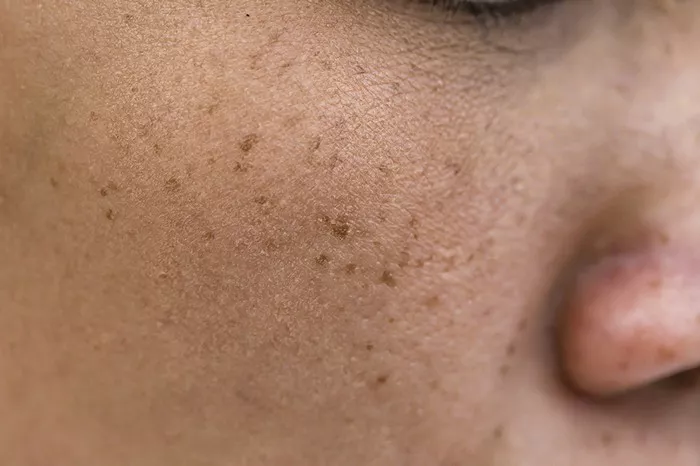Freckles are small, flat, brown spots that appear on the skin, particularly on areas that are exposed to the sun. While freckles are harmless, many people find them unsightly and may wish to have them removed. In this article, we will explore the causes of freckles, discuss at what age they typically stop appearing, and explore treatment options for those who wish to remove them.
What Causes Freckles?
Freckles are caused by an overproduction of melanin, the pigment that gives skin its color. When the skin is exposed to the sun, the melanin-producing cells in the skin, called melanocytes, produce more melanin in an effort to protect the skin from UV radiation.
This increase in melanin production can result in the formation of freckles, particularly in people with fair skin or who are prone to sunburn. Freckles can also be hereditary, meaning they may run in families.
At What Age Do Freckles Stop Appearing?
Freckles can appear at any age, but they are most common in children and young adults. As people age, their skin becomes less sensitive to UV radiation, and the production of melanin slows down.
This means that freckles may become less noticeable or stop appearing altogether as people get older. However, this is not always the case, and some people may continue to develop freckles throughout their lives.
Treatment Options for Freckles
While freckles are harmless, many people find them unsightly and may wish to have them removed. There are several treatment options available for those who wish to remove freckles, including:
Topical creams: There are several topical creams available that can help lighten or fade freckles over time. These creams typically contain ingredients like hydroquinone, retinoids, or vitamin C, which can help reduce the production of melanin in the skin.
Chemical peels: Chemical peels involve applying a solution to the skin that causes the outer layer of skin to peel off, revealing new, smoother skin underneath. Chemical peels can help reduce the appearance of freckles and improve the overall texture and tone of the skin.
Laser therapy: Laser therapy involves using a laser to target and destroy the melanin-producing cells in the skin. This can help reduce the appearance of freckles and prevent them from coming back.
Cryotherapy: Cryotherapy involves freezing the skin with liquid nitrogen, causing the freckles to peel off. This treatment is quick and relatively painless, but it may require multiple sessions to achieve the desired results.
It is important to note that while these treatments can be effective, they may also have side effects or risks associated with them. Be sure to discuss the risks and benefits of each treatment option with your dermatologist or skincare professional before deciding which is right for you.
Preventing Freckles
The best way to prevent freckles is to protect your skin from UV radiation. This can be done by wearing protective clothing, such as long-sleeved shirts and wide-brimmed hats, using a broad-spectrum sunscreen with an SPF of at least 30, and avoiding prolonged exposure to the sun during peak hours.
It is also important to maintain a healthy lifestyle, including eating a balanced diet, staying hydrated, and getting regular exercise. Additionally, avoiding smoking and excessive alcohol consumption can help reduce the risk of premature aging and other negative effects on the skin.
Conclusion
Freckles are small, flat, brown spots that appear on the skin, particularly on areas that are exposed to the sun. While freckles are harmless, many people find them unsightly and may wish to have them removed.
By understanding the causes of freckles and the treatment options available, you can make an informed decision about how to manage your freckles. Remember to protect your skin from UV radiation and maintain a healthy lifestyle to help prevent the formation of freckles in the first place. Be sure to consult with a qualified dermatologist or skincare professional to develop a customized treatment plan that meets your individual needs and goals.
FAQs
1. Do you stop getting freckles as you get older?
While freckles may become less noticeable with age, especially as sun exposure decreases, some individuals continue to develop new freckles throughout their lives. Factors such as genetics, sun exposure, and skin type play a role in the development and visibility of freckles. While freckles may fade or become less prominent over time, they may still reappear with sun exposure or other triggers.
2. Can you get new freckles in your 30s?
Yes, it is possible to develop new freckles in your 30s and beyond, especially with continued sun exposure. Freckles are pigmented spots that result from an increase in melanin production in response to UV radiation. Therefore, individuals who spend time in the sun without adequate protection may notice new freckles forming, regardless of their age.
3. Can freckles go away over time?
Freckles can fade or become less noticeable over time, especially with reduced sun exposure and proper skincare. However, some freckles may persist or reappear with sun exposure or other factors that stimulate melanin production. While treatments such as laser therapy or chemical peels may help lighten or remove freckles, it’s essential to consult a dermatologist for personalized recommendations.
4. Does freckled skin age prematurely?
Freckled skin may show signs of premature aging, such as fine lines, wrinkles, and sunspots, if not adequately protected from UV radiation. Sun exposure is a significant contributor to premature aging of the skin, as UV radiation can damage collagen and elastin fibers, leading to loss of elasticity, sagging, and the formation of wrinkles. Therefore, individuals with freckles should take precautions to protect their skin from the sun by wearing sunscreen, seeking shade, and wearing protective clothing.


